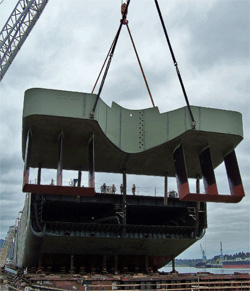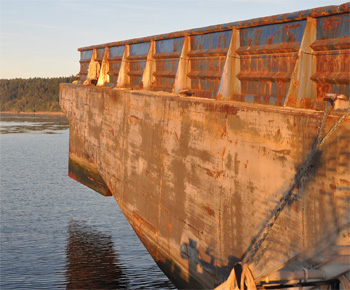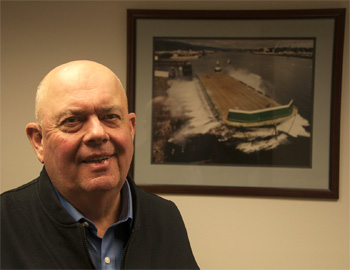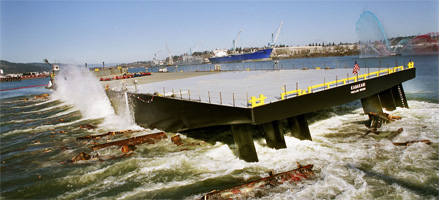“We have built over 30 barges with Hydralift Skegs for several different companies since the early 1990s,” said Chuck Garman of Gunderson Marine in his office at the Portland, Ore., shipyard. Garman has been around the marine industry since he started work for the legendary “Doc” Freeman on Seattle’s Lake Union back in the 1960s. Garman and his industry have come a long way since those early days.
The tug and barge industry has a long and proud history on the Pacific Coast. The steep mountain-lined shores of British Columbia and Alaska have discouraged road and railway building so that for many communities barges are the primary means of heavy transport.
Up until the 1950s, the massive old-growth timbers still available allowed for the construction of some fine big wooden barges. By the 1960s, the demand for larger barges and the decline in suitable wood resulted in a growth in the number of steel barges. There were some successful conversions of ships into towable barges, but this was not enough to meet the demand for deck and tank barges in both U.S. and Canadian waters.
 |
|
Courtesy Gunderson Marine |
|
Another barge's stern section is lifted into place. |
Increasingly barges were in demand for long crossings of open waters such as the Gulf of Alaska passage from Southeast Alaska to the Bering Sea and from the Washington and Oregon coasts to Hawaii. Distance of tows led to larger barges and more powerful tugs. In the 1970s development of Alaska’s North Slope oil, one major firm developed big 400-by-100-foot barges. These had raked bows and plum sterns. Towing a square box, even with a raked bow and stern, behind a tug has always created tracking problems. A barge that is sheering to port and starboard travels farther than necessary when going from point A to point B.
Soon long-haul barges were being built with a rake to the stern as well as the bow to reduce the turbulence that created a drag on the barge. The raked stern also made a space for the addition of skegs to help the barge track straight. Trial and error soon established that angling the skegs by 3° or 4° toward the trailing edge was the most effective at keeping the barge following along with the tug in an orderly fashion.
The combination of skegs and shaping of the bow and stern of the barges was a significant improvement. Like so much in the marine world there existed an “if it ain’t broke don’t fix it” approach to barge design. In North Vancouver, British Columbia, a naval architect and hydrodynamic engineer named Josip Gruzling set up shop in 1972, under the name Nautican Research and Development Ltd., and had some remarkable success with a propeller nozzle design and a triple rudder system. Companies like Seattle’s Western Towboat had embraced this work that revisited and improved on more traditional nozzle designs. Gruzling next turned his attention to those established skeg designs.
Observation and tank testing showed significant drag-inducing turbulence around the skegs. This was created by the skeg having the same effect as setting a ship’s rudder at 2° or 3° right or left rudder. The port skeg was angled inward as was the starboard skeg to provide equal pressure and help the barge maintain straighter tracking. This worked for that purpose, however it also created fuel-burning and/or speed-reducing resistance or drag on the tow. It was a crude and inelegant approach to the challenge of having a long-haul barge track effectively. Gruzling, applying his knowledge of hydrodynamics, studied the problem and arrived at an elegant solution. He called these new skegs Hydralift in recognition of the modified airfoil shaping that he applied. Before his death in 2007, he had installed the new skegs and they had won industry acceptance.
Since Gruzling’s death, his firm has been sold but continues under the direction of industry veteran Elizabeth Boyd and it continues to design and market efficient hydrodynamic products. “Elizabeth is a very knowledgeable in hydrodynamics,” said Mike Whalen by phone, as he explained some of the finer points of utilizing the Nautican Hydralift Skegs. His Seattle-based firm of naval architects Hockema & Whalen Associates has been designing barges with Hydralift Skegs from 300 to 480 feet in length and typically around 100 feet on the beam. But he feels in some applications the Hydralift Skegs could offer advantages to smaller barges as well. “Cost recovery is fairly quick with the Hydralift Skegs,” he explained. “They add only 4 to 8 percent resistance compared to 25 percent or more resistance from conventional skegs.”
 |
|
Alan Haig-Brown |
|
A typical "barn door" type skeg. The combination of the skegs and the shaping of the bow helps maintain straighter tracking. |
He went on to explain that these skegs give the owner the “biggest bang for his buck,” although making use of computational fluid dynamics (CFD) can also save owners considerable money over building a model and tank testing it. Ten or 15 years ago the CFD programs were not so reliable, but current CFD technology is significantly improved. Working with the customer’s basic design specs, they are now able to create hull forms with various combinations of design parameters. “We once had 1,000 different hull forms by varying details like the bilge radius in combination with other variables,” recalled Whalen, “and then the program can look at each variable independently.”
But a designer can also start with an existing design and then modify a set of controlled parameters and immediately test the result to see if it is an improvement. “CFD amounts to a virtual model tank,” Whalen said. With the latest versions of CFD design, an actual tank test of a model will confirm the results whereas a decade ago there was more often some inconsistency.
The eventual cargo function of a barge is one of the first design criteria as there can be a trade-off between the hull shape and the carrying capacity. In the case of a tank barge, a designer’s options for hull design are more limited as it will typically carry cargo to the load line leaving much more of the molded depth under water. On the other hand, a barge designed to carry containers will not normally load to the hull’s load line capacity. This, in turn, allows for a shapelier hull. The more technical of Hockema & Whalen’s barges have evolved to meet the demands of schedule-dependent companies towing barges from the lower 48 states to Alaska or Hawaii.
Conventional skegs are like huge barn doors providing drag to keep the barge towing straight. Whalen explains that the Hydralift Skegs are formed like aircraft wings to provide horizontal lift with the three to four “wings” working in opposition to keep the barge tracking straight. The horizontal foil gives some barely perceptible lift, but is primarily intended to provide structural support to the vertical members. “In an unusual accident, one barge tore off a skeg on one side while underway,” Whalen recounted. “The barge rotated almost 90° due to the lift effect of the remaining skeg. They had to drag a couple of container flats on that side of the barge to equalize the effect and get home.”
 |
|
Alan Haig-Brown |
|
Chuck Garman of Gunderson Marine is an advocate of Hydralift Skegs. The design has become something of a specialty at Gunderson, which has built more than 30 barges with the skegs. |
The CFD has helped in the overall design, said Whalen. “It has allowed us to refine the shape to create a more streamlined bow. We have optimized where the shoulder of a barge is in relation to the humps and hollows of the bow wave. This can create low pressure points to reduce the secondary wakes in a similar fashion to the function of a bulbous bow on a ship’s hull.”
Dale Sause of Sause Bros. Inc., based in Coos Bay, Ore., has worked with Nautican, Hockema & Whalen and Gunderson Marine to design and build a number of the company’s 25 barges. An early adopter of the Hydralift Skegs, he explained in a recent interview that his firm did early testing work with Gruzling in a Swedish model tank in 2006. He appreciates the value of CFD in refining a barge’s hull shape. He said, “A barge shaped like a shoe box has a prismatic of 100 percent. As you carve away pieces of the bow and the stern, this is reduced. The finer the lines, the lower the prismatic. A typical 1970s barge with a rake on the bow and a cube body had a .88 to .89 prismatic.”
The company has had Bay-class double-hulled tank barges built at Gunderson Marine. These 380-foot by 76-foot by 31-foot barges are the optimum size for towing petroleum products on the Pacific Coast. As fuel prices and operating costs grow and operators everywhere continue to search for efficiency in their operations, the combination of advanced skeg design and computational fluid dynamics will continue to make significant contributions. Although the long ocean tows typical of West Coast operations have driven the development of these efficient barges, Whalen is confident that it is only a matter of time before others see the advantages.

